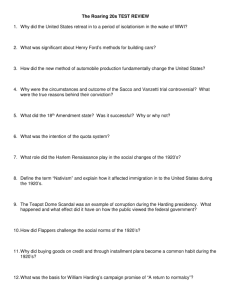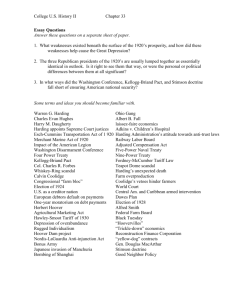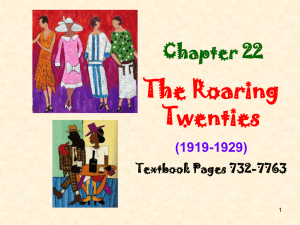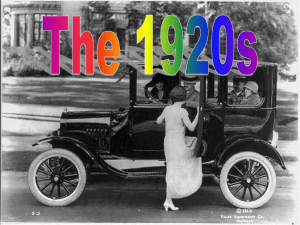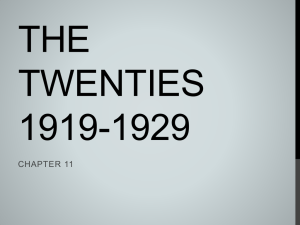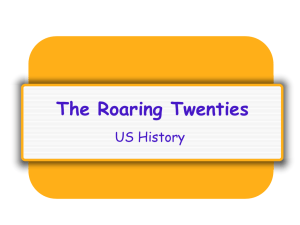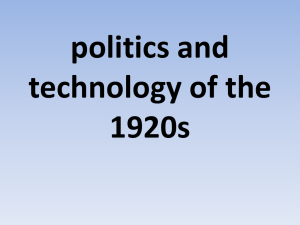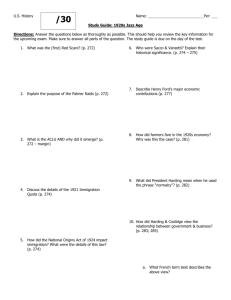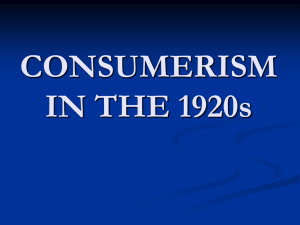American History Chapter 10 On-Line Study Guide
advertisement
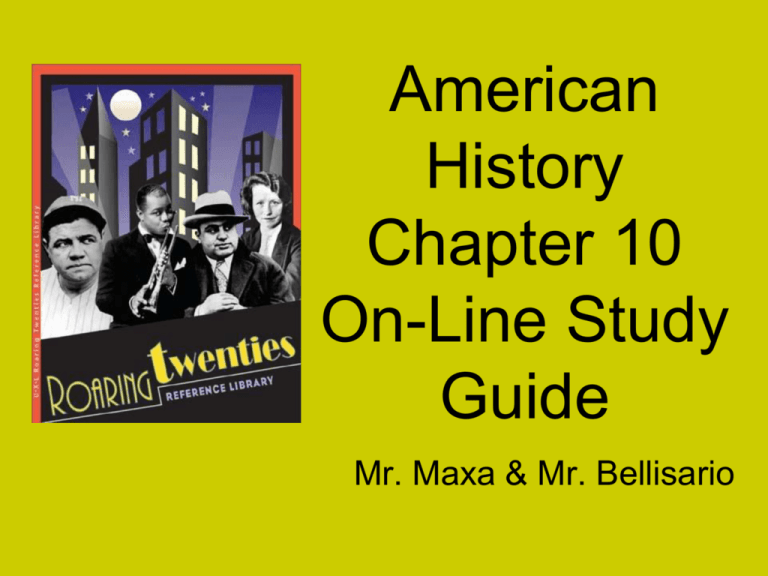
American History Chapter 10 On-Line Study Guide Mr. Maxa & Mr. Bellisario Table of Contents • Section 1 • Section 2 • Section 3 • Section 4 • Section 5 SECTION 1 President Warren G. Harding Promise of “return to normalcy” • Warren G. Harding was elected president in 1920. • He ran on the campaign promise to return the country to normalcy. • This meant a return to “normal” life after the war. Harding Cabinet Why was it bad • Harding appointed many friends from Ohio to cabinet positions and high-level jobs. • Some members of Harding cabinet used their positions to sell jobs, pardons, and protection from prosecution. • His friends were not the most qualified individuals for their jobs. The Ohio Gang • It was a group of President Harding’s poker playing friends. Teapot Dome Scandal • The most famous scandal was Teapot Dome. • Secretary of the Interior Albert B. Fall, secretly allowed private companies to lease lands containing Navy oil reserves. • Fall became the first cabinet officer to go to prison. Calvin Coolidge He takes over as President • In a 1923 tour of the West, President Harding fell ill and died. • Vice President Calvin Coolidge became president and distanced himself from corruption. • He restored integrity to the presidency. • In 1924 he easily won the election. Coolidge’s Philosophy on Business • Coolidge believed his job was to make sure government interfered as little as possible with business. Andrew Mellon Secretary of Treasury • Mellon had three major goals as secretary of the treasury: – Balance the budget – Reduce government debt – Cut taxes • Mellon convinced Congress to create agencies to prepare the budget and track expenses. • He then cut government spending. Supply-Side Economics Trickle-Down Economics • Mellon argued that if taxes were lower, businesses and consumers would spend and invest more. • As the economy grew, the government would collect more taxes at a lower rate than if taxes were high. • This idea is known today as supply-side economics. American Isolationism • By the end of the war, allies owed the United States more than $10 billion. • Many Americans at this time favored isolationism or staying out of world affairs. • Isolationism was the policy of the U.S. in the 1920’s. The Washington Conference • Secretary of State Charles Evans Hughes spoke to the major world powers at a conference in Washington. • The conference led to a treaty between Britain, France, Italy, Japan, and the United States to reduce the naval arms race. Kellogg-Briand Pact • The United States and fourteen other nations signed the Kellogg-Briand Pact. • The Pact was an agreement to settle all disputes peacefully. SECTION 2 Henry Ford’s Assembly Line • Henry Ford used the assembly line to build cars. • This system divided operations into simple tasks unskilled workers could do. • It reduced the time needed and the cost. Mass Production • Mass production, or large scale product manufacturing done mainly by machinery, made more products available and lowered costs. • This reshaped American economics and industry. Ford’s Philosophy on Business • Henry Ford’s car, the Model T was mass produced on the assembly line. • Ford believed that by lowering the price of his mass-produced car, the Model T, he would created a huge demand. Ford’s treatment of workers and his “Sociological Department” • Henry Ford increased • Ford also created a his workers wages to Sociological $5 per day (working 8 Department which set hours) helping to requirements that undermine the decline workers had to meet. of unions. Auto Commuter • The automobile reduced the isolation of rural areas and allowed people to live farther from work. Disposable Income & New Household Products • With their greater incomes, people bought new products such as frozen foods, household cleaners, washing machines, and cosmetics. Wright Brothers • The Wright brother from Dayton, OH completed the first air-powered flight in Kitty Hawk, NC. Charles Lindbergh • Charles Lindbergh, the first person to fly solo across the Atlantic Ocean (transAtlantic), gave the idea of commercial flights a boost. KDKA • KDKA was the first radio station in the United States. Credit • Before the 1920s, most Americans thought that going into debt was shameful. • This attitude changed, and more Americans went into debt to buy items such as furniture and bought cars on credit. Mass Advertising • Manufactures used mass advertising as a way to promote their new products. Welfare Capitol • Welfare capitalism was the practice of companies allowing employees to invest in the company, thus motivating employees to work harder. Farming Crisis in the 1920’s –Why? • During the war, the government had encouraged farmers to grow more to meet the need for food in Europe. • Many farmers went into debt to buy more land and machinery to raise more crops. • Sales and prices were high, so farmers prospered. • After the war, Europeans began producing more farm products, so profits fell for American farmers. • New technologies such as fertilizers, machinery, and new seed varieties allowed farmers to produce more, but demand for the products did not increase, so farmers received lower prices for their goods. McNary-Haugen Bill • Was a proposed law that Congress passed. • The bill stated that the government would buy American crops surpluses and sell them in Europe. • President Coolidge voted the bill. SECTION 3 Nativism • Nativism is the belief that a person’s country needs to be protected against immigrants. • Nativism was popular during the 1920s. Sacco & Vanzetti Case • Two Italian immigrants were accused of murder. • Sacco and Vanzetti, admitted anarchist, were arrested, convicted, and executed. Return of the KKK – Why? • During the 1920s, the KKK rose from the underground to oppose immigrants, Catholics, Jews, African-Americans. • The KKK publicized their support of legitimate political goals. Emergency Quota Act & National Origins Act Emergency Quota Act • Restricted annual admission to the US to only 3% of the total number of people in any ethnic group already living in the nation. National Origins Act • Made immigration restriction a permanent policy The Changing Role of Women – Flapper • Some women (not the majority) during the 1920 changed the way they dressed and presented themselves publically. Fundamentalism vs. Evolution • Fundamentalists were a group of Christians who interpreted the bible word-for-word. • They rejected the theory of evolution, which argued that human beings had developed from lower forms of life over the course of millions of years. • Fundamentalists believed in creationism, which says that God created the world as described in the Bible. Scopes Monkey Trial • In 1925 Tennessee outlawed the teaching of evolution. • A high school biology teacher named John T. Scopes was tried and convicted of breaking this law. • The Scopes Trial helped illustrate the struggle between the new morality and traditional beliefs. Prohibition – 18th Amendment – Speakeasies • In January of 1920 the Eighteenth Amendment went into effect. • This amendment prohibited, or banned, the sale of alcohol. • Many people felt prohibition would reduce unemployment, violence, and poverty. Organized Crime – Bootlegging • Organized crime grew with prohibition. • In Chicago, IL, Al Capone became the most famous gangster. 21st Amendment • The 21st Amendment repealed the 18th Amendment. • Prohibition was over and people were legally allowed to drink alcohol again. SECTION 4 The “Lost Generation” • A group of writers in the 1920s including F. Scott Fitzgerald and Ernest Hemmingway who describe modern life as spiritually empty and materialistic. F. Scott Fitzgerald • F. Scott Fitzgerald’s novel, The Great Gatsby exposed the emptiness of modern society. Babe Ruth • New York Yankee’s slugger, Babe Ruth became a national hero. SECTION 5 Harlem Renaissance • New York City’s Harlem neighborhood became the center for the flourishing African American arts known as the Harlem Renaissance. Langston Hughes • Langston Hughes became the leading voice of the African American experience during the Harlem Renaissance and was by far the most famous writer. Jazz • Jazz was a style of music that was influenced by ragtime and Dixieland blues during the 1920’s. Cotton Club • The Cotton Club was a Harlem nightspot that featured African American entertainers but served only white customers. Marcus Garvey • Marcus Garvey was a dynamic leader from Jamaica. • He founded a group called the Universal Negro Improvement Association (UNIA). • Garvey believed African Americans could gain economic and political power through education. • He also called for separation from white society. • Garvey planned to lead his followers back to Africa. Back to the Table of Contents

